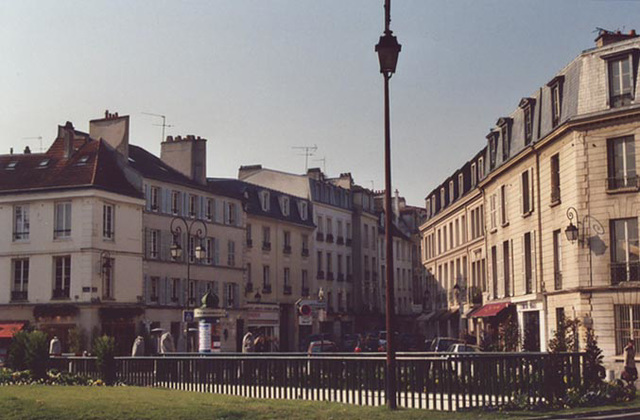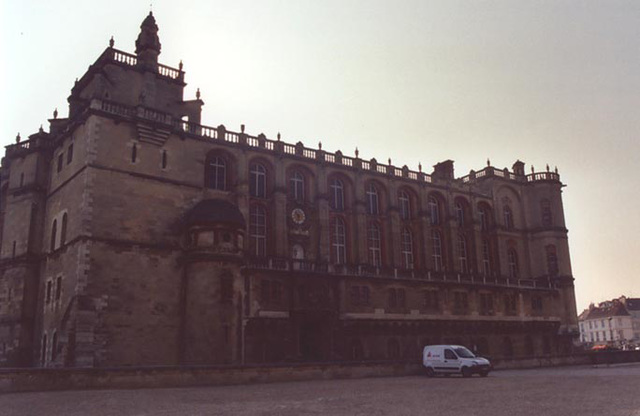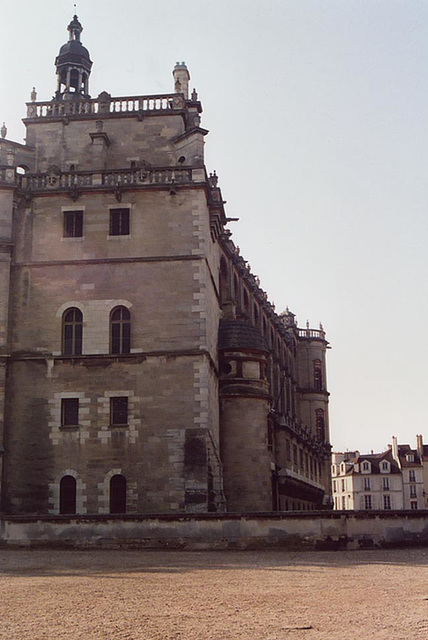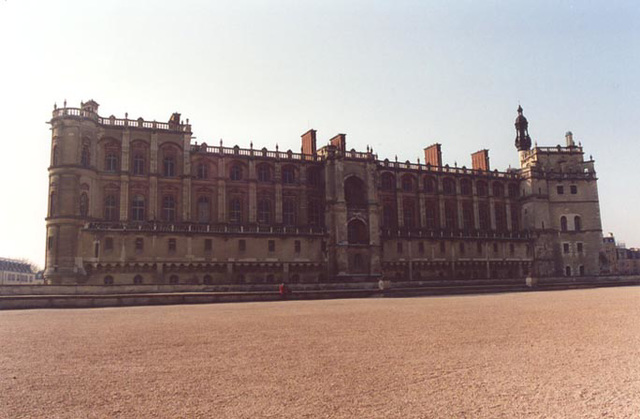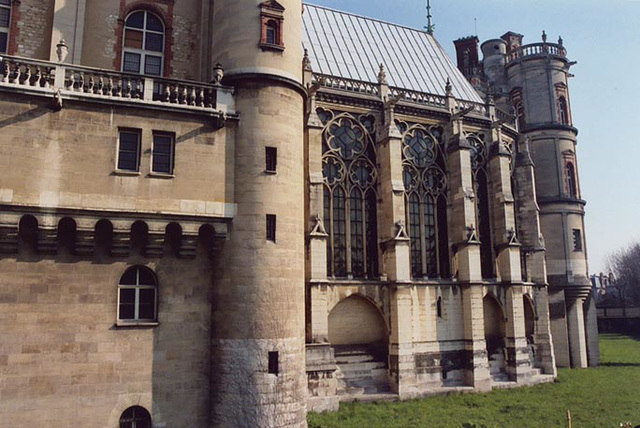
St. Germain-en-Laye, March 2004
The old chateau was constructed in 1348 by King Charles V on the foundations of an old castle dating from the time of Saint Louis in 1238. François I was responsible for its subsequent restoration. In 1862-1867, Napoleon III set up the Musée des Antiquités Nationales in the old castle. This museum has exhibits ranging from Paleolithic to Celtic times. (from Wikipedia)
01 Mar 2004
The Town and RER Stop in St.Germain en-Laye, 2004
Saint-Germain-en-Laye is a commune in the western suburbs of Paris in France. It is located 19.1 km (11.9 miles) from the center of Paris. Inhabitants are called Saint-Germanois.
It is a sous-préfecture of the Yvelines département, being the seat of the Arrondissement of Saint-Germain-en-Laye. It covers approximately 4,800 hectares, making it the largest commune in Yvelines. It occupies a large loop of the Seine, and includes the National Forest of Saint-Germain-en-Laye. The town of Saint-Germain-en-Laye lies at the western terminus of the RER A1 urban railway.
Saint-Germain-en-Laye was founded in 1020 when King Robert the Pious (ruled 996-1031) founded a convent on the site of the present Church of Saint-Germain. Prior to the French Revolution in 1789, it had been a royal town and the residence of numerous French monarchs.
The old château was constructed in 1348 by King Charles V on the foundations of an old castle dating from 1238 in the time of Saint Louis. François I was responsible for its subsequent restoration. In 1862, Napoleon III set up the Musée des Antiquités Nationales in the old castle. This museum has exhibits ranging from Paleolithic to Celtic times. The "Dame de Brassempouy" sculpted on a mammoth's ivory tusk around 23,000 years ago is the most famous exhibit in the museum.
Kings Henri IV and Louis XIII left their mark on the town.
Louis XIV was born in the city (its coat of arms consequently shows a cradle and the date of his birth), and established Saint-Germain-en-Laye as his principal residence from 1661 to 1681. Louis XIV turned over the château to King James II after his exile from Britain after the Glorious Revolution in 1688. King James lived in the Château for 13 years, and his daughter Marie-Louise Stuart was born in exile here in 1692. King James Stuart is buried in the Church of Saint-Germain.
Saint-Germain-en-Laye is famous for its 2.4 kilometre long stone terrace built by André Le Nôtre from 1669 to 1673. The terrace provides a view over the valley of the Seine and, in the distance, Paris.
During the French Revolution, the name was changed along with many other places whose names held connotations of religion or royalty. Saint-Germain-en-Laye became Montagne-du-Bon-Air.
In the 19th century, Napoleon I established his cavalry officers training school in the Château-Vieux.
During the occupation from 1940 to 1944, the town was the German Army Headquarters
Saint-Germain-en-Laye is served by Saint-Germain-en-Laye station on Paris RER line A.
It is also served by two stations on the Transilien Paris – Saint-Lazare suburban rail line: Saint-Germain – Bel-Air – Fourqueux and Saint-Germain – Grande Ceinture.
Finally, Saint-Germain-en-Laye is also served by Achères – Grand Cormier station on Paris RER line A and on the Transilien Paris – Saint-Lazare suburban rail line. This station is located in the middle of the Forest of Saint-Germain, far away from the urbanized part of the commune.
Text from: en.wikipedia.org/wiki/Saint-Germain-en-Laye
01 Mar 2004
St. Germain Chateaux, 2004
Chateaux of St. Germain-en-Laye, located just outside of Paris, which now houses the French national antiquities museum.
01 Mar 2004
St.Germain Chateaux 2004
Chateaux of St. Germain-en-Laye, located just outside of Paris, which now houses the French national antiquities museum.
Saint-Germain-en-Laye was founded in 1020 when King Robert the Pious (ruled 996-1031) founded a convent on the site of the present Church of Saint-Germain. Prior to the French Revolution in 1789, it had been a royal town and the residence of numerous French monarchs.
The old château was constructed in 1348 by King Charles V on the foundations of an old castle dating from 1238 in the time of Saint Louis. François I was responsible for its subsequent restoration. In 1862, Napoleon III set up the Musée des Antiquités Nationales in the old castle. This museum has exhibits ranging from Paleolithic to Celtic times. The "Dame de Brassempouy" sculpted on a mammoth's ivory tusk around 23,000 years ago is the most famous exhibit in the museum.
Text (second paragraph onward) from: en.wikipedia.org/wiki/Saint-Germain-en-Laye
01 Mar 2004
St.Germain Chateaux 2004
Chateaux of St. Germain-en-Laye, located just outside of Paris, which now houses the French national antiquities museum.
Chateaux of St. Germain-en-Laye, located just outside of Paris, which now houses the French national antiquities museum.
Saint-Germain-en-Laye was founded in 1020 when King Robert the Pious (ruled 996-1031) founded a convent on the site of the present Church of Saint-Germain. Prior to the French Revolution in 1789, it had been a royal town and the residence of numerous French monarchs.
The old château was constructed in 1348 by King Charles V on the foundations of an old castle dating from 1238 in the time of Saint Louis. François I was responsible for its subsequent restoration. In 1862, Napoleon III set up the Musée des Antiquités Nationales in the old castle. This museum has exhibits ranging from Paleolithic to Celtic times. The "Dame de Brassempouy" sculpted on a mammoth's ivory tusk around 23,000 years ago is the most famous exhibit in the museum.
Text (second paragraph onward) from: en.wikipedia.org/wiki/Saint-Germain-en-Laye
01 Mar 2004
St.Germain Chateaux Garden 2004
Garden of the chateaux of St. Germain-en-Laye, located just outside of Paris.
Saint-Germain-en-Laye was founded in 1020 when King Robert the Pious (ruled 996-1031) founded a convent on the site of the present Church of Saint-Germain. Prior to the French Revolution in 1789, it had been a royal town and the residence of numerous French monarchs.
The old château was constructed in 1348 by King Charles V on the foundations of an old castle dating from 1238 in the time of Saint Louis. François I was responsible for its subsequent restoration. In 1862, Napoleon III set up the Musée des Antiquités Nationales in the old castle. This museum has exhibits ranging from Paleolithic to Celtic times. The "Dame de Brassempouy" sculpted on a mammoth's ivory tusk around 23,000 years ago is the most famous exhibit in the museum.
Text (second paragraph onward) from: en.wikipedia.org/wiki/Saint-Germain-en-Laye
01 Mar 2004
St. Germain Chateaux, 2004
Chateaux of St. Germain-en-Laye, located just outside of Paris, which now houses the French national antiquities museum.
Chateaux of St. Germain-en-Laye, located just outside of Paris, which now houses the French national antiquities museum.
Saint-Germain-en-Laye was founded in 1020 when King Robert the Pious (ruled 996-1031) founded a convent on the site of the present Church of Saint-Germain. Prior to the French Revolution in 1789, it had been a royal town and the residence of numerous French monarchs.
The old château was constructed in 1348 by King Charles V on the foundations of an old castle dating from 1238 in the time of Saint Louis. François I was responsible for its subsequent restoration. In 1862, Napoleon III set up the Musée des Antiquités Nationales in the old castle. This museum has exhibits ranging from Paleolithic to Celtic times. The "Dame de Brassempouy" sculpted on a mammoth's ivory tusk around 23,000 years ago is the most famous exhibit in the museum.
Text (second paragraph onward) from: en.wikipedia.org/wiki/Saint-Germain-en-Laye
01 Mar 2004
St. Germain Chateaux, 2004
Chateaux of St. Germain-en-Laye, located just outside of Paris, which now houses the French national antiquities museum.
Chateaux of St. Germain-en-Laye, located just outside of Paris, which now houses the French national antiquities museum.
Saint-Germain-en-Laye was founded in 1020 when King Robert the Pious (ruled 996-1031) founded a convent on the site of the present Church of Saint-Germain. Prior to the French Revolution in 1789, it had been a royal town and the residence of numerous French monarchs.
The old château was constructed in 1348 by King Charles V on the foundations of an old castle dating from 1238 in the time of Saint Louis. François I was responsible for its subsequent restoration. In 1862, Napoleon III set up the Musée des Antiquités Nationales in the old castle. This museum has exhibits ranging from Paleolithic to Celtic times. The "Dame de Brassempouy" sculpted on a mammoth's ivory tusk around 23,000 years ago is the most famous exhibit in the museum.
Text (second paragraph onward) from: en.wikipedia.org/wiki/Saint-Germain-en-Laye
01 Mar 2004
St. Germain Chateaux Chapel, 2004
Chateaux of St. Germain-en-Laye, located just outside of Paris, which now houses the French national antiquities museum.
Saint-Germain-en-Laye was founded in 1020 when King Robert the Pious (ruled 996-1031) founded a convent on the site of the present Church of Saint-Germain. Prior to the French Revolution in 1789, it had been a royal town and the residence of numerous French monarchs.
The old château was constructed in 1348 by King Charles V on the foundations of an old castle dating from 1238 in the time of Saint Louis. François I was responsible for its subsequent restoration. In 1862, Napoleon III set up the Musée des Antiquités Nationales in the old castle. This museum has exhibits ranging from Paleolithic to Celtic times. The "Dame de Brassempouy" sculpted on a mammoth's ivory tusk around 23,000 years ago is the most famous exhibit in the museum.
Text (second paragraph onward) from: en.wikipedia.org/wiki/Saint-Germain-en-Laye
01 Mar 2004
St. Germain Chateaux, 2004
Chateaux of St. Germain-en-Laye, located just outside of Paris, which now houses the French national antiquities museum.
Chateaux of St. Germain-en-Laye, located just outside of Paris, which now houses the French national antiquities museum.
Saint-Germain-en-Laye was founded in 1020 when King Robert the Pious (ruled 996-1031) founded a convent on the site of the present Church of Saint-Germain. Prior to the French Revolution in 1789, it had been a royal town and the residence of numerous French monarchs.
The old château was constructed in 1348 by King Charles V on the foundations of an old castle dating from 1238 in the time of Saint Louis. François I was responsible for its subsequent restoration. In 1862, Napoleon III set up the Musée des Antiquités Nationales in the old castle. This museum has exhibits ranging from Paleolithic to Celtic times. The "Dame de Brassempouy" sculpted on a mammoth's ivory tusk around 23,000 years ago is the most famous exhibit in the museum.
Text (second paragraph onward) from: en.wikipedia.org/wiki/Saint-Germain-en-Laye
Jump to top
RSS feed- Latest items - Subscribe to the latest items added to this album
- ipernity © 2007-2024
- Help & Contact
|
Club news
|
About ipernity
|
History |
ipernity Club & Prices |
Guide of good conduct
Donate | Group guidelines | Privacy policy | Terms of use | Statutes | In memoria -
Facebook
Twitter

